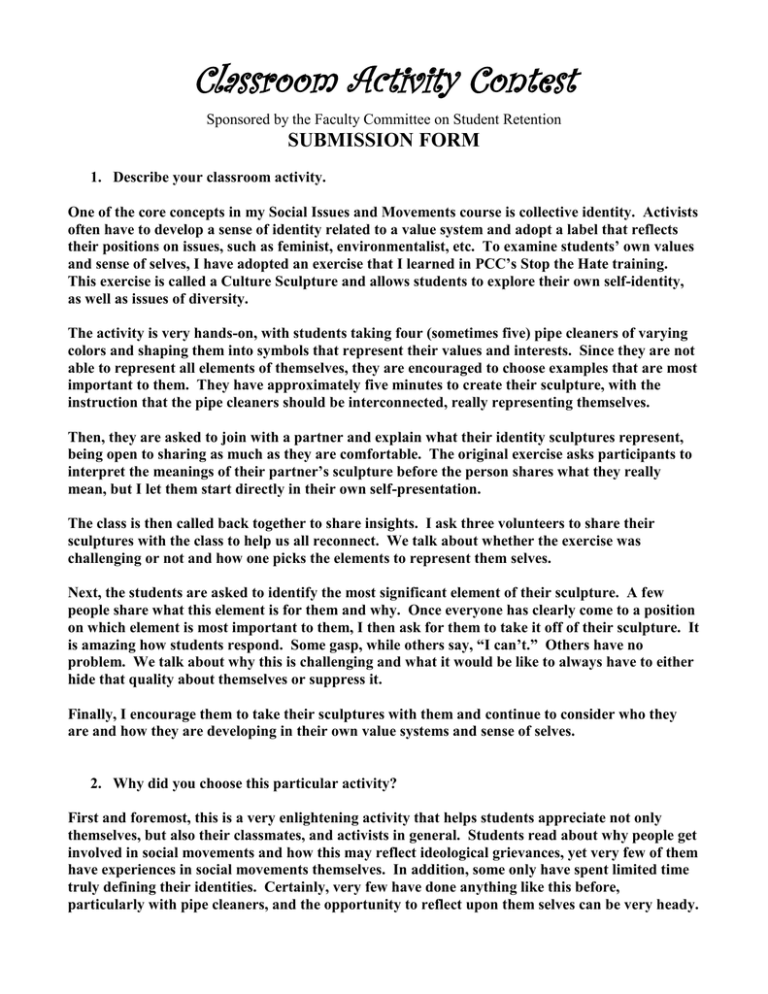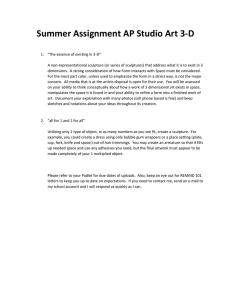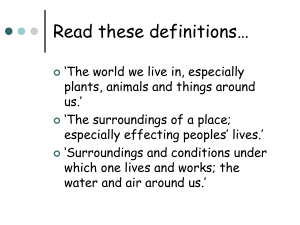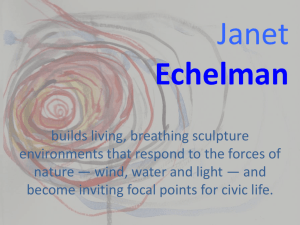Submission 46
advertisement

Classroom Activity Contest Sponsored by the Faculty Committee on Student Retention SUBMISSION FORM 1. Describe your classroom activity. One of the core concepts in my Social Issues and Movements course is collective identity. Activists often have to develop a sense of identity related to a value system and adopt a label that reflects their positions on issues, such as feminist, environmentalist, etc. To examine students’ own values and sense of selves, I have adopted an exercise that I learned in PCC’s Stop the Hate training. This exercise is called a Culture Sculpture and allows students to explore their own self-identity, as well as issues of diversity. The activity is very hands-on, with students taking four (sometimes five) pipe cleaners of varying colors and shaping them into symbols that represent their values and interests. Since they are not able to represent all elements of themselves, they are encouraged to choose examples that are most important to them. They have approximately five minutes to create their sculpture, with the instruction that the pipe cleaners should be interconnected, really representing themselves. Then, they are asked to join with a partner and explain what their identity sculptures represent, being open to sharing as much as they are comfortable. The original exercise asks participants to interpret the meanings of their partner’s sculpture before the person shares what they really mean, but I let them start directly in their own self-presentation. The class is then called back together to share insights. I ask three volunteers to share their sculptures with the class to help us all reconnect. We talk about whether the exercise was challenging or not and how one picks the elements to represent them selves. Next, the students are asked to identify the most significant element of their sculpture. A few people share what this element is for them and why. Once everyone has clearly come to a position on which element is most important to them, I then ask for them to take it off of their sculpture. It is amazing how students respond. Some gasp, while others say, “I can’t.” Others have no problem. We talk about why this is challenging and what it would be like to always have to either hide that quality about themselves or suppress it. Finally, I encourage them to take their sculptures with them and continue to consider who they are and how they are developing in their own value systems and sense of selves. 2. Why did you choose this particular activity? First and foremost, this is a very enlightening activity that helps students appreciate not only themselves, but also their classmates, and activists in general. Students read about why people get involved in social movements and how this may reflect ideological grievances, yet very few of them have experiences in social movements themselves. In addition, some only have spent limited time truly defining their identities. Certainly, very few have done anything like this before, particularly with pipe cleaners, and the opportunity to reflect upon them selves can be very heady. Classroom Activity Contest Sponsored by the Faculty Committee on Student Retention I am amazed at how deep some of them actually get into wanting and needing to clearly express themselves and how disappointed others feel if they have not thought so deeply before and are not able to come up with clear examples. Note that this can take some classroom and emotional management at times. This teaching technique also addresses different learning styles, with the benefit of capitalizing on kinesthetic skills. The innovation and creativity of the exercise also help students think and express themselves in different ways. It seems to use a different part of the brain, yet can capture really powerful abstract concepts, whether a student uses hearts, peace signs, or trees. Finally, I believe in integrating group work and small group discussion into classes, when appropriate. This exercise allows students to connect on deeper levels and helps them to not only reflect on themselves, but to also learn about others. Beyond the richness in discussion, this helps students to develop emotional bonds, which builds a stronger sense of community in the class for the remainder of the term. 3. What are the activity outcomes? Hands-on, kinesthetic learning Interactive creative engagement Personal reflection Rich course discussion Clarity of course concepts on personal and collective identity Community building Understanding and appreciation of diversity 4. What were the intended activity outcomes? See above.







